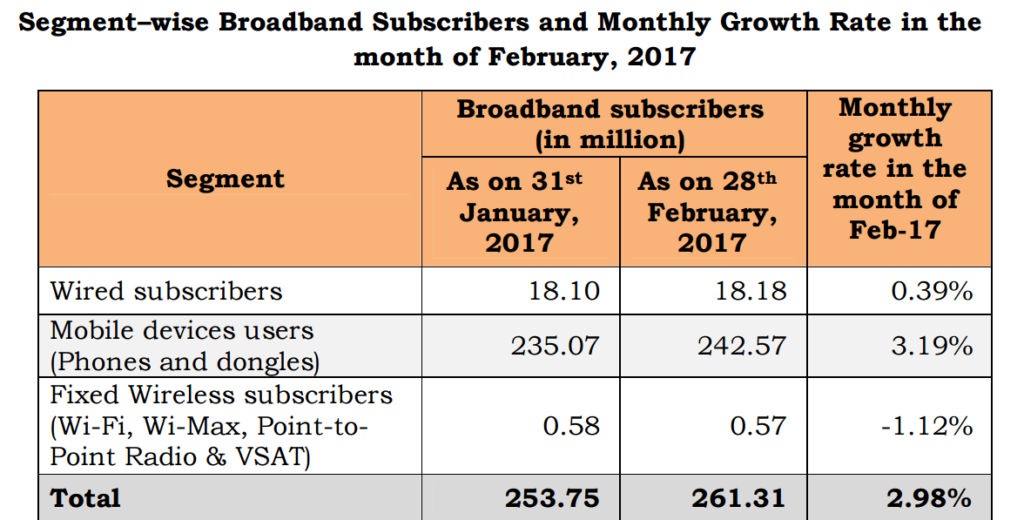When Professor Leonard Kleinrock sent the first ever message over ARPANET to Stanford Research University, he could have scarcely imagined that this was the birth of an omnipresent network that would one day connect every corner of the world. The internet contains the total of nearly all human knowledge and has pervaded every aspect of our lives. The rise of the “Internet of Things” phenomenon is now opening the power of the Internet to a whole new world of innovation. Considering the immense importance of the internet in the modern world, the poor state of Internet connectivity in India for so many years was shocking. However, over the past year, there has been something of an internet renaissance in India. You may not be too surprised to know that the impetus for this transformation is none other than Reliance Jio. Data from TRAI reveals that Reliance Jio is single handily driving the growth of broadband subscribers in India.
Reliance Jio Is Connecting India To The Internet
Reliance has been a tremendous disruptive presence in the Indian Telecom Industry ever since its launch. Not only has it transformed the cellular communication landscape in India, but it is also doing the same for broadband. The total number of broadband subscribers in India as of 31 August 2016 was 171.71 million. The subsequent release of Jio caused this number to shoot up to nearly 192.30 million by the end of September 2016, at an 11.99% growth rate. The total number of broadband subscribers in India has continued to grow at a tremendous pace since then, totalling at 261.31 million at the end of February 2017.
This represents a massive 52.2% growth in a mere six months! Reliance Jio is undoubtedly driving these levels of unprecedented growth. Jio now accounts for 39.36% of all broadband connections in India with 102.84 million users, all wireless. This is more than double than Airtel’s combined user-base of 46.69 million.
In the wired broadband segment, state-owned BSNL reigned supreme with 9.95 million subscriptions. Airtel followed at a distant second with 2.07 million users. However, Jio is set to challenge even in this segment soon with the upcoming Reliance Jio broadband service. Jio is widely expected to launch a Fibre-to-the-Home (FTTH) broadband service offering speeds up to 1 Gbps. The trial program has already started. However, we have no word on a launch date or pricing yet.
India Is Wireless, Albeit Slow
Another very defining feature of the Indian broadband scene is the skewed ratio of wireless to wired subscribers. In mature markets such as the US, we find the number of fixed broadband subscriptions to be relatively high at 92.9 million as of Q4 2016. The number of people accessing the internet on mobile is about 225 million.
Generally, mobile internet users are categorised into two: Narrowband users and broadband users. Narrowband users are the ones which are still hooked with second generation data connectivity, also known as 2G, while broadband users are active consumers of high speed 3G/4G data connectivity.
In India, unlike the US, the story is entirely different. As of 28 February 2017, the number of wired broadband subscribers was a mere 18.18 million. In contrast, the number of mobile internet users – connected with high only 3G/4G network – reached a whopping 242.57 million. This means that nearly 92.83% of broadband users in India are using mobiles and dongles! This trend will further propagate with time, as the monthly growth rate for wired subscriptions in February 2017 was only 0.39% as opposed to 3.19% for mobile devices.

4G LTE networks were the primary source of data traffic in India in 2016. Nearly 60% of the incremental data payload from 2015 levels contributed by 4G. 3G also remained highly relevant, registering 25% growth in 2016. Together, 4G and 3G contributed to 76% of all data traffic across India. For the first time, 2G data volumes dipped in 2016 as Indian users migrated to faster modern networks.
Internet Speeds Are Improving, But Wireless Remains Inconsistent
2016 was a good year for the Internet in India. The average Internet speed grew by a whopping 99%, clocking in at 5.6 Mbps as of Q4 2016. India ranked 2nd in terms of growth rate in APAC, second only to Vietnam. Despite being significantly behind APAC leaders South Korea (26.1 Mbps), this represents a significant improvement. Of course, a large portion of the credit has to go to Reliance Jio. However, as we reported earlier, there is a worrying inconsistency in internet performance. Low speeds, high latency and inconsistent speeds are plaguing Jio. In fact, OpenSignal’s data suggests that Jio’s 4G (LTE) downloading speed is actually slower than Airtel and Vodafone’s 3G downloading speed. These issues need to be ironed out to provide a world-class internet experience to Indian users. Jio is reportedly collaborating with Samsung to upgrade and enhance their telecom infrastructure over the next few years.
Takeaways
- Reliance Jio has led to a boom in broadband subscribers in India. This will be very helpful in the creation of a “Digital India”. Investment in the online ecosystem can be beneficial to all kinds of businesses, big or small.
- Wired broadband is still lagging behind in India. Wired offers the benefits of higher data caps, lower latency and higher speeds – all of which are essential for activities such as media streaming and video calling. The launch of Jio broadband may change this and provide a better platform for these service providers.
- India experienced a massive growth in the average internet speed in 2016, clocking at 5.6 Mbps. India is now finally equipped for a more dynamic internet experience with more audio, video and images. Websites and application developers should upgrade their offerings to take full advantage of the higher available bandwidth.
- Despite significant improvement in internet infrastructure high-speed mobile internet in India remains inconsistent. Reliance Jio, especially, suffers from high latency and poor speeds. This negatively affects real-time experiences such as video calling.

